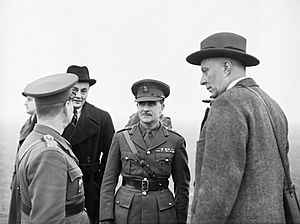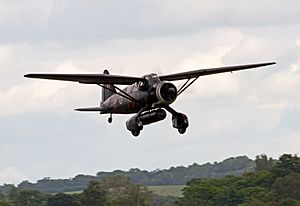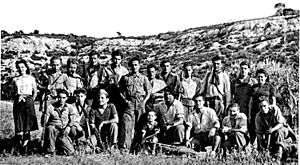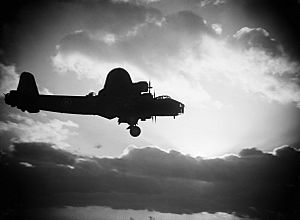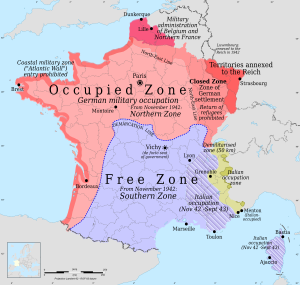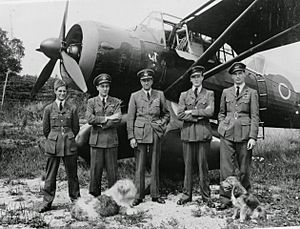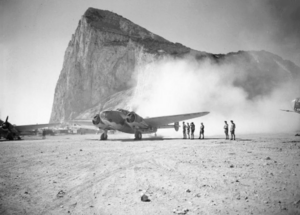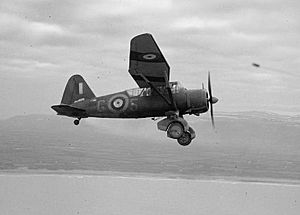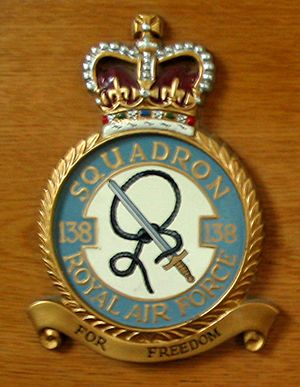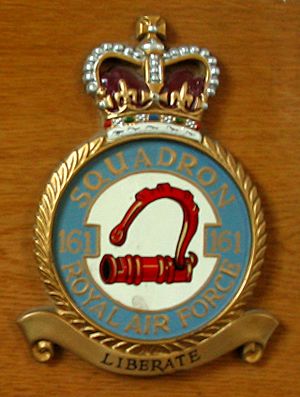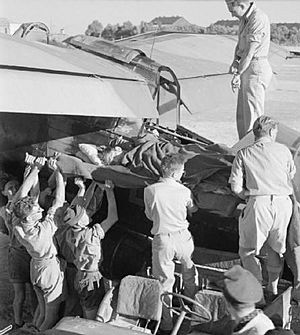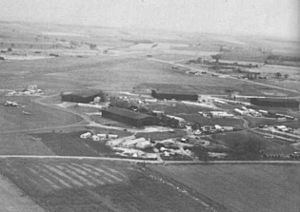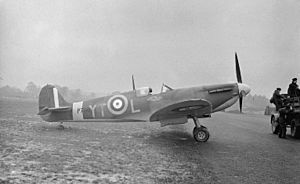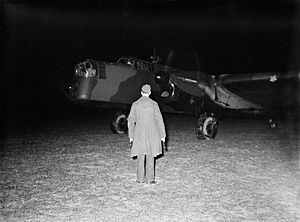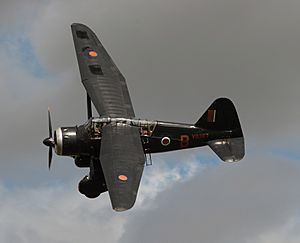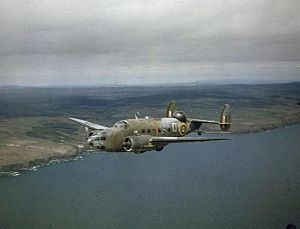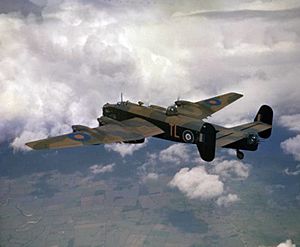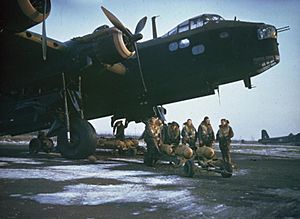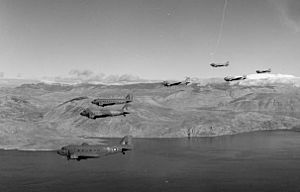Royal Air Force Special Duties Service facts for kids
Quick facts for kids Royal Air Force Special Duties Service |
|
|---|---|
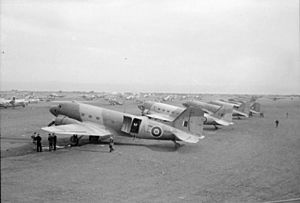
SD Dakotas in Italy
|
|
| Active | 21 August 1940 – 30 August 1945 |
| Country | |
| Allegiance | Allies |
| Branch | Royal Air Force |
| Role | Air transport and supply support for resistance movements in the occupied territories. |
The Royal Air Force Special Duties (SD) Service was a top-secret air group. It helped resistance movements in countries controlled by the Axis powers during World War II. This service brought in secret agents, radio operators, and important supplies.
Most supplies and agents were dropped by parachute. The SD Service also created an "air taxi" service. This service picked up agents, political leaders, and secret messages from occupied Europe. They brought them safely back to England. On the way out, these air taxis also delivered agents and valuable packages to France.
Special Duties flights went to many places. These included Vichy France, Occupied France, Belgium, the Netherlands, Norway, Poland, Czechoslovakia, Yugoslavia, and Greece. By the end of the war, SD units were also working in the Far East. The Royal Air Force controlled these air units. They worked closely with the SOE and the SIS.
Starting the Secret Service
After France fell in June 1940, Prime Minister Winston Churchill wanted to create a resistance movement in Europe. His goals were two-fold. First, he wanted to build a spirit of resistance in Nazi-controlled countries. Second, he wanted to create a secret army of fighters. These fighters would help free their countries when the British returned.
To support this, a way to communicate and deliver supplies was needed. A very secret organization was formed on July 22, 1940. It was called the Special Operations Executive (SOE). Only the highest government officials knew about it. The SOE tried hard to keep its existence a secret. It used different names when dealing with other groups.
The Air Ministry was asked if agents could be flown or parachuted into France. At first, the idea was not popular. Air marshal Charles Portal and Arthur Harris did not want to use planes for "spies." But Churchill disagreed. The SOE got its support, and the Special Duties service units were created.
The missions of these air units were kept very secret. This was sometimes hard. In 1942, a plane crashed, killing five secret agents. The public was told they were reporters. When a local newspaper asked more questions, the Army stopped the story. Pilots had to lie about their work. Their secret remained hidden for over 30 years after the war.
The first flight unit was formed on August 21, 1940. It was part of 11 Group Fighter Command. Control later moved to 3 Group. As the SOE grew, so did the air units. Eventually, the RAF created two "Special Duties" squadrons. A third was added in 1943 for the Mediterranean area. A fourth was added in 1944 for the Far East. These squadrons supported both the SOE and the SIS. The SOE needed most of the air transport. The busiest time was around the Allied invasion of Europe in June 1944.
Training for Secret Missions
The first job for the RAF was to deliver agents to France. These agents needed to find good fields for planes to land and take off. They also had to speak French perfectly to blend in. Once an agent was in place, they would choose possible landing spots.
Training Operators on the Ground
French people trained as agents were also trained as "operators." They were called chef de terrain in French. Training happened at "Joe School" in London and then at RAF Tempsford. Special duties pilots from 161 Squadron helped. This training took place during the darkest part of the moon cycle.
Pilots taught operators what to look for in a landing field. It needed a clear path, free of trees or wires, at least 600 yards long. The ground had to be firm, avoiding mud.
Agents were French, French people living in England, or resistance members brought from France. Some were even former French pilots. They learned to signal aircraft using Morse code. They also learned to set up flare paths. For supply drops, five flashlights made an "X." For a Lysander landing, three flashlights made an inverted "L."
The RAF preferred to land only on fields managed by their trained operators. If an operator chose bad fields, they would get more training. After a dangerous mission in 1942, the RAF insisted on this rule.
Training Pilots for Secret Flights
Special duties squadrons needed to find and train pilots. Since it was a secret group, recruiting was hard. Some pilots joined through friends. Others had escaped from Europe themselves. All had "Above Average" pilot skills. Many were also good navigators. Being able to navigate alone was very important. Pilots flew at night over enemy land, often in bad weather. They had to find a small, dark field in France. They needed to be self-reliant and think for themselves.
It took about a month to train a pilot. The pilot had to know the plane's controls very well. They learned to plan a route to their target and back. The route used "pinpoints," which were easy-to-spot landmarks. The path was about 50 mi (80 km) wide to avoid German anti-aircraft guns. Pilots practiced flying by navigation alone over England, day and night. Then they practiced night landings and take-offs from a grass field. This training happened at "RAF Somersham," a fake airfield used for training.
The final test for a Lysander pilot was to fly over France to a target south of Saumur. The target was described as a light. When the pilot arrived, he saw a brightly lit rectangle. It was a prison camp, but its lights made it a perfect "pinpoint." If the pilot found it, he was ready for missions.
Secret Operations
Dropping Supplies by Parachute
Delivering supplies was the main job for the Special Duties squadrons. Resistance groups needed a lot of materials. As more people joined, the need grew. In May 1941, an officer thought supplying 45,000 fighters would need 2,000 flights a year. Supplies included weapons, explosives, radios, bicycles, food, clothing, and medicine. Special items like radio crystals and printer's ink were also sent. For Norwegians, skis and sleds were dropped.
Most supplies to France were carried by 138 Squadron. 161 Squadron also dropped agents and supplies. Both squadrons needed moonlight to see the landing fields. On the ground, an operator would wait at a chosen field. When they heard the plane, they would flash a secret Morse code letter. The plane would flash back a matching letter. The ground team would then light the field with five lights in an "X" shape. The plane flew very low, about 400 to 500 feet, and slowly. This helped keep the cargo from scattering or getting damaged. The operator would have a plan to hide the supplies quickly.
Supplies were usually dropped in cylindrical containers. C-type metal containers were 6 feet long and weighed up to 250 pounds. They could carry rifles. The "H" type, developed by the Poles, could be broken into five smaller parts for easier hiding. Smaller packages weighed less than 100 pounds. Some items, like boots, were "free-dropped" by just throwing them out. About 20% of missions were cancelled due to bad weather or no reception committee. Valuable items like fake documents were often carried by agents on Lysander planes.
The SD crews spent a lot of time over enemy territory. Their first tour of duty was completed after 250 hours of flight. This was more than the usual 30 missions for Bomber Command crews. The need for supplies grew as the invasion neared. 138 Squadron's ability to carry cargo improved in December 1943. They received Short Stirling bombers. These planes became permanent in 1944.
Dropping Agents by Parachute
Most agents arrived in France by parachute. This was not a gentle daytime drop. They were dropped at night from 500 to 600 feet. This was just high enough for the parachute to open a few seconds before landing. About 1,500 agents were dropped into France. Many did several drops. The aircrews called agents "Joes." If the plane was too low, landings could be rough. Six agents died from failed drops during the war. Agent drops usually happened during the moonlit period.
Pick-up Flights
Pick-up missions were handled by 161 Squadron's A Flight. Each pick-up had a special name. If a pick-up failed, the same name was used for later attempts. By 1942, a routine was set. A resistance group would ask for a pick-up. They would choose a landing spot and send details to London. The RAF would photograph the field. The pilot would then make a route map of France.
Pilots used landmarks like rivers and lakes to navigate. Water reflected moonlight, making it easy to see. The Loire river was a common guide. A sharp bend with two small islands near Blois was a key landmark. Pilots flew low over the English Channel to avoid German radar. Crossing the French coast was dangerous due to German guns. Cabourg was a favored crossing point.
Pilots would climb to 8,000 ft (2,400 m) over the coast to avoid light anti-aircraft fire. Then they dropped to 2,000 to 1,500 ft (610 to 460 m) over France to see landmarks better. Once near the target, the ground agent would signal a secret Morse code letter.
The pilot would flash back the correct Morse code response. Then, the ground team would light the flare path. This was three flashlights on poles, forming an inverted "L." The pilot would circle and land. Lysander landing lights came on just before touchdown. The pilot aimed for the "A" lamp and stopped near the "B" lamp. He would turn at the "C" lamp and taxi back to "A" for the exchange. Passengers got on and off in under three minutes. The operator often greeted the pilot. There were quick hellos and gifts. Then, the plane took off again in less than 150 yd (140 m).
Sometimes, landings happened at abandoned French airfields. Lysander pilots faced many dangers: anti-aircraft fire, German night fighters, bad weather, and mud. Bad weather and muddy fields were the most dangerous. German anti-aircraft guns were known, so careful plotting helped avoid them. German night fighters were a threat, especially for planes flying to Poland.
Being caught on the ground by the Gestapo was a constant fear. If a plane got stuck, it had to be destroyed. The pilot would then try to escape on foot. This often meant a long journey through escape routes, over the Pyrenees mountains, and into Spain. From there, they hoped to reach the British consulate and fly home. In November 1943, Robin Hooper's Lysander got stuck in mud. Another Lysander was sent to pick him up. That night, fog caused the loss of two Lysanders and three Halifaxes. This was the worst night of losses for the Special Duties squadrons.
To reduce capture risk, passenger changes were practiced to be very fast. The goal was three minutes. Pilots carried pistols and escape kits. Their biggest fear was a muddy field. If stuck, they had to get airborne before daylight and German patrols. If delayed, they might fly a different route. One pilot, "Mouse" Fielden, flew his Hudson over the Mediterranean to a British airfield in Algiers.
Pick-up flights were seen as glamorous, but pilots got little public credit. Their Lysanders were often used for target towing or rescue practice. So, other airmen sometimes looked down on them. But Lysander pilots had high morale. They were proud to rescue agents from Europe, right under the Gestapo's nose. After D-Day in June 1944, the entry point changed to avoid Allied fire. Bad weather was the main reason missions failed. Pilots would try to reach the target even in bad weather, using their last known position and speed. But they still needed a clear view to see the lights and land.
Special Air Units
Flight 419 and Flight 1419
The first RAF special duties unit was Flight 419. It started on August 21, 1940, at RAF North Weald. Flight Lt. Wallace Farley commanded it, with two Lysanders. Before Farley, Acting Flight Lt John Coghlan was in charge. He was lost on a mission to Belgium on August 17/18. By September, three Whitleys and another Lysander were added. The first secret flight was on September 3, 1940. Wing Commander Andrew Geddes flew an SIS agent to France in a Lysander.
First Secret Mission
Flight 419's first mission was on October 19/20, 1940. Flight Lt. Farley went to pick up SIS agent Philip Schneidau. Schneidau had parachuted into France ten days earlier. They had planned his pick-up. Since small radios were not available, Schneidau brought 10 messenger pigeons. They planned a 3-light flare path for the landing. This simple flare path was used for Lysander landings throughout the war. Schneidau had also added a ladder to the Lysander to make climbing easier.
On the night of the pick-up, heavy wind and rain cancelled all RAF flights. But Farley convinced his commander to let him try. The weather cleared over France. Farley found Schneidau's field, landed, and picked him up. As they left, a German guard shot Farley's plane. The bullet went into the cockpit, between Farley's legs, and hit the compass.
On the way back, a strong storm blew them north and east. Rain and wind made the radio useless. Schneidau became very cold. They flew through the night, not knowing if they were over England, the North Sea, or Germany. Six hours later, they were low on fuel. Finally, a break in the clouds showed them a small plateau on a rugged coastline. With no other choice, they landed and crashed through anti-glider posts. They were six miles north of RAF Oban in Scotland, 600 miles from Farley's home base.
Two Scottish guardsmen found them. They were taken in as suspected spies. Farley only gave his name and service number. Schneidau said they were on a special Atlantic mission but could not give his name. The base commander confined them. Meanwhile, Farley's commander was searching for them. When he heard a Lysander crashed in Scotland and the pilot was Farley, he knew his man was back. This was the start of the RAF Special Duties squadrons' secret work.
Managing the Secret Flights
The special duties service needed its own support. Normal RAF procedures for bombing raids were not good for secret flights. Flight 419 was first controlled by No. 11 Group RAF. In September, Flight 419 moved to Stradishall after its base was bombed. Control switched to 3 Group, which supported all Special Duties squadrons. Two Whitleys were added in September. Many early Whitley missions went to Poland. In February 1941, Flight 419 became No. 1419 Flight RAF to avoid confusion with No. 419 Squadron RAF. The flight moved several times before returning to Stradishall in October.
No. 138 (Special Duties) Squadron
On August 25, 1941, Flight 1419 grew into 138 (Special Duties) Squadron. This squadron did most of the heavy work, delivering supplies and agents to France and other occupied countries. It had 2 Lysanders, 10 Whitleys, 3 Halifaxes, and a Martin Maryland. The squadron flew during moonlit periods to remote fields. They had no special navigation tools. Planes kept radio silence over enemy territory. They navigated by themselves. Planes flew at about 2,000 feet over the continent. They dropped to 400-500 feet near the drop point. Speed was reduced to minimize scatter and damage. Drops had to be accurate for agents to get and hide the materials.
Agents were dropped from 600 feet. This was just enough time for the parachute to open. If the plane was too low, landings were very hard. Many agents were injured. The Lysanders did pick-up operations and formed B Flight in 138 Squadron.
In February 1942, the squadron split. Its Lysanders, Whitleys, and Halifaxes joined with the King's Flight to form 161 Squadron. After the split, 138 Squadron still handled most supply and agent drops. 161 Squadron did all personnel pick-ups. They also landed agents who could not parachute. In March 1942, the squadron moved to the secret airfield at Tempsford. It stayed there until the war ended. Many Polish pilots flew in 138 Squadron. In July 1943, they formed their own unit, Flight 301.
By the end of the war, 138 Squadron flew over 2,500 missions. They dropped 29,000 containers, 10,000 packages, and 995 agents into Europe. They lost 70 aircraft. Over half these missions used Handley Page Halifax bombers. These were changed to have a parachute hatch called the "Joe hole." 138 Squadron became a regular unit on March 9, 1945. The squadron's badge showed a sword cutting a rope, with the motto "For Freedom".
No. 161 (Special Duties) Squadron
161 (Special Duties) Squadron formed on February 15, 1942. It combined 138's Lysander flight with Whitleys and Wellingtons. Pilots and planes from the King's Flight also joined. Edward Fielden, an experienced pilot, commanded the unit. 161's A Flight had 6 Lysanders, led by Guy Lockhart. A Flight did pick-up operations. The squadron's B Flight flew two-engine Whitleys and Wellingtons. They dropped agents and supplies. In November 1942, the Whitleys were replaced with four-engine Halifaxes.
The squadron moved to RAF Tempsford in April 1942. This was its home base for the war. During full moon periods, A Flight moved to RAF Tangmere. Tangmere was on the coast, 100 miles south of Tempsford. This extended the Lysanders' reach into Europe. 161 Squadron delivered SOE agents, radio equipment, and weapons to the resistance. From France, they brought back French political leaders, resistance leaders, and agents whose cover was blown. Sometimes, they rescued Allied airmen. Their goal was to make pick-up operations as reliable as a London taxi. The squadron also trained operators. After a bad pick-up in April 1942, the RAF demanded tighter control. They only allowed pick-ups with operators trained by 161's pilots. The squadron's badge was a released shackle, with the motto "Liberate".
No. 148 (Special Duties) Squadron: Mediterranean
In 1943, a special duties squadron was created for the Mediterranean. 148 Squadron became 148 (Special Duties) Squadron. It went to Algiers to support an SOE unit called 'Massingham'. The unit's Halifaxes dropped supplies to resistance fighters in southern France, Italy, and the Balkans. In February, Peter Vaughan-Fowler led a flight of Lysanders. They picked up agents in Greece, Yugoslavia, and southern France. The unit helped in the Warsaw airlift and lost many planes. 148 (SD) Squadron worked until the war ended.
No. 357 (Special Duties) Squadron: Far East
In 1944, No. 357 (Special Duties) Squadron started operations in the Far East. They flew Liberators, Dakotas, Lysanders, and Catalina Flying Boats. They supported SOE's Force 136 in Burma and other resistance groups in Thailand and Malaya. 357 (Special Duties) Squadron dropped more supplies by weight in the Far East than any other RAF unit dropped in bombs.
Secret Airfields
RAF Tempsford
Tempsford was in a quiet part of Bedfordshire. It was built on Gibraltar Farm land. The airfield was developed in 1940 as a secret "A" class airfield. Locals knew there was an RAF station, but little else. Flights happened at night, so farmers saw little. The airfield was built over a bog, which later caused fog problems. It was mostly empty until the SD squadrons arrived in 1942. 138 Squadron moved there on March 11, 1942. 161 Squadron followed on April 10, 1942. The first secret supply mission from Tempsford was on March 18, 1942.
Tempsford was not a typical RAF airfield. It had three runways in a triangle and a track around the field. Hugh Verity, a former commander, called it "not much of an RAF station." RAF Tempsford looked like a normal farm. SOE agents stayed in a local hotel before coming to the farm buildings. No one was allowed to see or talk to the agents. One brick building was disguised with wood siding. This was called Gibraltar Farm. It was unusual to have buildings inside an airfield, but Tempsford had them. After briefings at the farm, agents got firearms in the barn. Then they boarded a waiting plane.
Germans wanted to find the SD base but never did. Twice, a German agent was found near the airfield.
RAF Tangmere
RAF Tangmere was 100 miles south of RAF Tempsford, on the English coast. It was mainly a fighter base. But during moonlit periods, Lysanders and their ground crews came to Tangmere. This put them closer to France, extending their range. Tangmere had two Spitfire squadrons, so the German air force paid attention to it. After Flight 419's second successful pick-up, Gordon Scotter returned to Tangmere during an attack. He had to circle until it was safe to land.
At Tangmere, the Lysanders were parked separately. Pilots stayed and planned flights at a local home called Tangmere Cottage. Hedges hid the cottage. It was also used by the SOE for final checks on agents leaving and for meals for returning agents. During the day, pilots ate at the regular RAF officer's mess.
161 pilots flew to Tangmere for two weeks during the "moon period." This was a week before and a week after the full moon. The cover story for the Lysanders was that they did "photographic reconnaissance by night." The extra fuel tank under the plane was said to hold special cameras. Jimmy McCairns, a Lysander pilot, believed this story earlier in his career.
Fog over England was a big danger for returning flights. More special duties aircrew died from accidents due to fog than any other reason. On December 16/17, 1943, bad weather caused five Tempsford SD aircraft to be lost. 138 Squadron lost three Halifaxes. One crashed into the sea, one crash-landed, and the crew of another bailed out. That same night, fog claimed two of 161 Squadron's Lysanders. Lysander pilots had parachutes, but their passengers did not. Pilots had to try to land the plane if they had passengers. One crashed trying to land at RAF Tangmere. The pilot was trapped, but his two passengers survived. The other Lysander crashed into a hillside. There were no survivors from that flight.
Aircraft Used
Armstrong Whitworth Whitley
The Whitley was a main aircraft for special duties for the first two years. This two-engine bomber joined service in 1937. It had a crew of five and could carry 7,000 pounds. The Whitley was made for night operations. For special duties, a "Joe hole" hatch was cut into the bottom for easy exit. The Whitley was famous for carrying paratroopers in the Bruneval raid. Over 1,000 Whitleys were made after the war started. They were used for cargo and agent drops in 138 Squadron and 161 Squadron's B Flight. 138 Squadron used Whitleys until November 1942. Then, they were replaced by the four-engine Halifax bomber.
Westland Lysander
The Lysander was the main plane for pick-ups throughout the war. It was designed to work with the Army, spotting for artillery and moving people. In 1940, many Lysanders were lost in France during the day. They were too slow for contested airspace. Of 178 Lysanders sent to France, 118 were destroyed. So, they were retired from this role. However, the Lysander was great at landing and taking off in short distances. This made it perfect for secret missions behind enemy lines. It had special parts that extended when flying slowly. These parts increased lift and lowered its stall speed.
The aircraft was changed for SD missions. Bomb racks and machine guns were removed. Its range was extended by adding a 150-gallon fuel tank. This increased its range from 600 miles to 1,150 miles. The large radio was replaced with a smaller one. A bench for two passengers was put in the observer area. A ladder was fixed to the side. 1943 was the busiest year for Lysanders. The Moon Squadrons made 125 landings in France.
Lockheed Hudson
If more than three people needed to be picked up, 161 Squadron would send two Lysanders. This was called "a double." Coordinating two planes at night was hard. Radio use also had risks. A larger plane was considered. The squadron had a Lockheed Hudson from the King's Flight. This plane worked well. The twin-engine Hudson had a range 200 miles (320 km) greater than the Lysander and was faster. Its three-person crew included a navigator and a radio operator. This took the navigation burden off the pilot. Most importantly, it could carry ten passengers, not just three. The downside was that the Hudson was heavier and needed a longer field to land.
Charles Pickard and Hugh Verity developed the Hudson for pick-up missions. Pickard found the Hudson's stall speed was slower than the manual said. They figured out how to land a Hudson in short fields. This allowed the squadron to carry up to ten people in one flight. The Hudson was three times heavier than the Lysander. It needed three times the landing length. So, the flare path was extended to 450 yards with two more lamps. The first Hudson mission was on February 13/14. Wing Commander Pickard flew five agents into France.
Handley Page Halifax
The Halifax was a four-engine bomber. It could carry 13,000 pounds, almost twice the Whitley's capacity. The Halifax replaced the Whitley in special duties squadrons in late 1942. It was used for parachuting supplies and agents. The Halifax had a much better range than the Whitley. This was a big advantage for long missions to Poland and the Balkans. SD Halifaxes were changed to carry metal supply containers. C-type containers were 6 feet long and weighed 250 pounds. Halifaxes could carry 15 of these, while Whitleys carried 12. The Halifax was the main supply plane for SD squadrons from late 1942 to mid-1944. Then, the Stirling replaced it.
Short Stirling
By mid-1943, the Short Stirling was available from Bomber Command for Special Duties. The Stirling was a very large aircraft. It was designed in the late 1930s as a heavy bomber. It had four engines and was huge. It could lift 14,000 pounds. Although heavy, Stirlings performed well at low and medium altitudes. They were very easy to maneuver for a large plane. They had a range of 3,000 miles. Stirlings could carry 20 C-type metal supply containers. This was 33% more than the Halifax. This aircraft became fully available in May 1944. By the end of the year, it had replaced the Halifax.
Douglas Dakota
The SOE used the American Douglas Dakota late in the war. It often landed in southern France. It also landed at airfields in areas held by resistance fighters in the Balkans.
Impact of the Secret Service
The SD pilots and aircrew received little public credit for their work. But these men were special. They were self-sufficient pilots who could solve problems on their own. They were excellent pilots and navigators. The life of a special operations airman was often lonely.
By the end of 1941, 138 Squadron had taken 37 agents to France and picked up 5. About 55% of their missions failed due to bad weather or not finding the ground operator. In 1942, the two SD squadrons (138 and 161) carried 23 tons of supplies and 155 agents to France. They picked up 19 people. In 1943, the SD squadrons flew 625 missions. They delivered 589 tons of supplies and carried 102 agents to France. They brought out 223 people.
By the time the SD squadrons stopped, they had flown over 13,500 missions. They brought in over 10,000 tons of supplies. About 60% of these supplies were delivered after the Normandy invasion. They parachuted in 1,800 agents. Another 324 agents came by Lysander or Hudson. They also picked up 593 political leaders, French resistance agents, family members, and Allied airmen. All were brought back to England. The SOE itself was closed six months after the war, on January 15, 1946.
One example of their effort was a pick-up mission on January 26/27, 1943. René Massigli was an important French political leader. He needed to reach Charles de Gaulle in England. Bad weather had delayed him since November. So, 161 Squadron commander Charles Pickard took the mission himself. He flew one agent out in terrible winter weather. He flew over a cloud-covered France, mostly by guessing his position. He reached the target area. Pickard was a very determined pilot. He could not see the signal light. He circled for two hours, even as his fuel got very low. Finally, a small break in the clouds showed him the signal light. He dropped through the clouds and landed quickly. Pickard gambled on returning to the nearest British airfield, RAF Predannack. He cleared France and most of the Channel. But as he neared the airfield, his luck and fuel ran out. Without power, he landed the Hudson safely, delivering his passengers.
Three weeks later, Pickard would fly a pick-up mission that earned him his third medal. A year after that, he died leading the Amiens prison raid.


